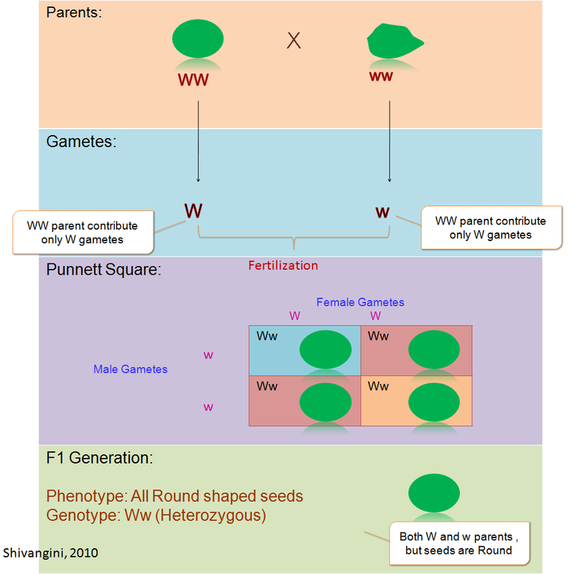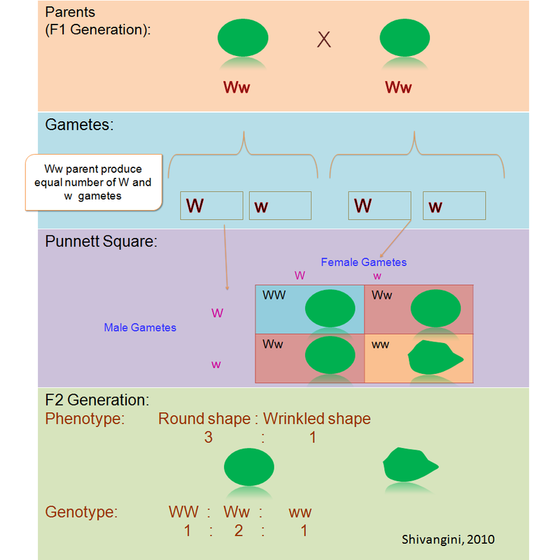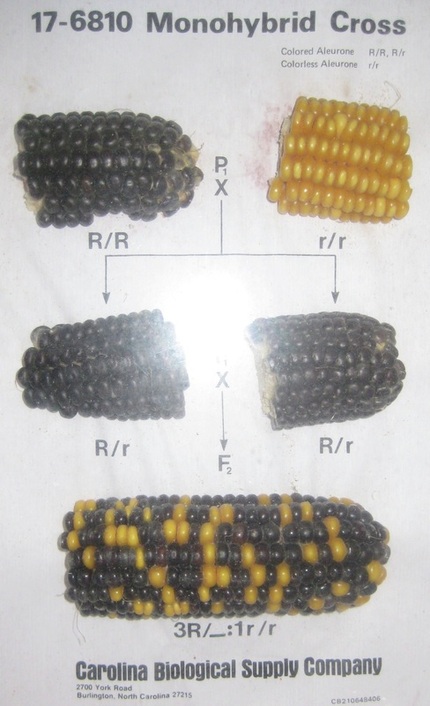Mendel studied the inheritance of single traits using the monohybrid cross. The experiment and the results are all summarized in the figure below.
When true breed Round seeds (WW) and wrinkled seeds (ww) were crossed the first generation (F1 generation) produced was Round seed (Ww).
Key points:
- All organism have two alleles for a particular trait / characteristic.
- Mendel used capital letter to denote dominant trait and small letters to denote recessive trait. Using this, W refers to round seeds and w refers to wrinkle seeds.
- F1 generation are heterozygous.
- Both parents give one of their allele to the child which pair up during fertilization to form the zygotes, that is, the offspring shows only one of the two parental trait. Tall height and short height are two traits noticed in humans, if a tall male and short female mate, the child will either be tall or short.
When F1 generation was self-fertilised it produced 3:1 ratio for Round: wrinkled seeds (Figure 2.2).
From this experiment Mendel reported that their were 5,474 Round and 1,850 Wrinkled peas.
Phenotype ratio: Round : Wrinkled
3 : 1
Genotype ratio: Homozygous Round : Heterozygous Round : Homozygous wrinkled
WW : Ww : ww
1 : 2 : 1
From this experiment Mendel reported that their were 5,474 Round and 1,850 Wrinkled peas.
Phenotype ratio: Round : Wrinkled
3 : 1
Genotype ratio: Homozygous Round : Heterozygous Round : Homozygous wrinkled
WW : Ww : ww
1 : 2 : 1
Key points:
- Traits can appear in the offspring that are not present in the parents.
Thinking Question:
If each parent has two alleles for a trait, why doesn't the offspring have altogether four alleles?
Mendel's Law of Segregation gives the reason to this behavior of alleles.
Key concept:
Law of Segregation:
In the formation of gametes, the paired genes separate (segregate) in such a way that each gamete is equally likely to contain either member of the pair.
The alleles separate from one another during formation of gametes. As a result, each offspring receives only one of the alleles which control a particular trait.
Example : If the parents genotype is Rr for a given trait, then half of the gametes would carry "R" and the other half will carry "r".
In the formation of gametes, the paired genes separate (segregate) in such a way that each gamete is equally likely to contain either member of the pair.
The alleles separate from one another during formation of gametes. As a result, each offspring receives only one of the alleles which control a particular trait.
Example : If the parents genotype is Rr for a given trait, then half of the gametes would carry "R" and the other half will carry "r".
Click on the video below to better understand the Law of segregation.
Relevance to real life:
A trait which follows Law of Segregation in humans are albinism. Albino have pale white skin, white hair and colorless eyes. Albinism is a recessive trait. Anyone carrying a "A" allele will have Colored skin, hair and eyes.
Maize show segregation too, they have yellow and purple seeds.
Maize show segregation too, they have yellow and purple seeds.
Now lets study about the Law of Independent Assortment. Click the next page icon.






